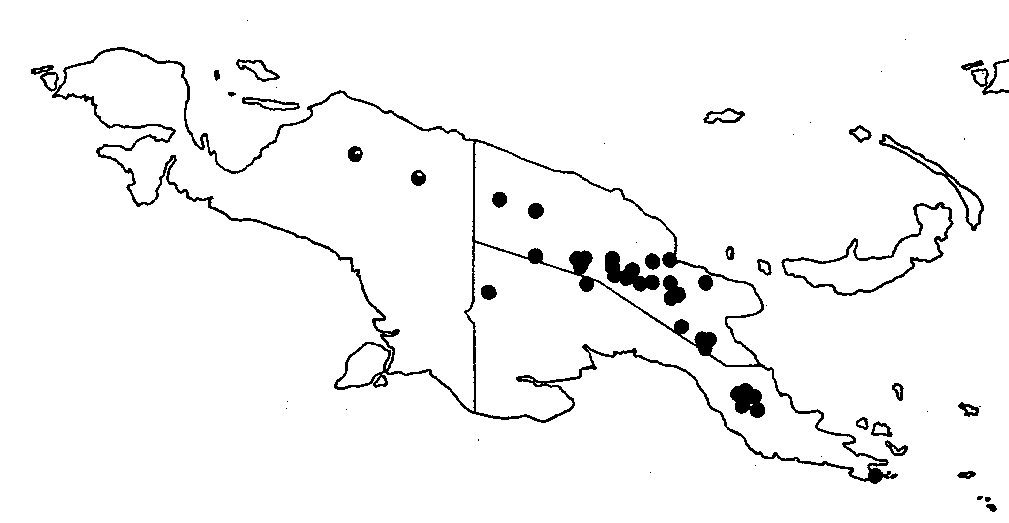
Distribution Map

Description (Barlow 1992)
Loranthus friesianus Schumann in Schumann & Lauterbach, Fl. Deutsch. Schutzgeb. Sildsee, Nachtr. (1905) 258. Amyema friesiana (Schumann) Danser, Bull. Jard. Bot. Buitenzorg III, 10 (1929) 295. - Type: Nyman 41 (lecto WRSL, see below), New Guinea, Stephansort, 22.xii.1898.
For descriptions see Danser, Bull. Jard. Bot. Buitenzorg III,
11 (1931) 295; Barlow, Austral. J. Bot. 22 (1974) 577; Flora of
Australia 22 (1984) 95. Amyema friesiana is a member of
the Amyema scandens species complex, which can be identified
in the Papuasian region by the inflorescence of a 4- to 8-rayed
umbel of triads with all flowers closely sessile in an equidistant
arrangement. Within this group it can be identified by its leaves,
which are regularly opposite, distinctly petiolate, almost curvinerved,
and acuminate acute at the apex. The corolla is described as orange
or red, often shading to paler orange, yellow, or green above.
The species is common and widespread in New Guinea (fig. 7; 65
collections seen), usually at elevations from 1500 to 2000 m,
but recorded from sea level to 2600 m, in primary and secondary
rain forests, parasitic on various hosts including Acalypha,
Calicarpa, Elaeocarpus, Ficus, Geunsia, Macaranga, Nauclea, Nothofagus,
and commonly Homalanthus. It also occurs in Cape York
Peninsula, Queensland. It is closely related to A. triantha
and A. plicatula, and these species together form a
cluster of opposite-leaved entities near the stem of the A.
scandens complex. See notes under A. scandens
and A. triantha.
Description (Barlow 1974)
Amyema friesianum (Schum.) Dans. Bull. Jard. bot. Buitenz. 10: 295 (1929);
11: 322 (1931); Loranthusfriesianus Schum. in Schum. &
Lauterb. Nachtr. 258 (1905). Type-New Guinea, Stephansort,
Nyman 41, 22.xii.1898 (B, holotype, not seen, probably
destroyed; WRSL).
Glabrous except for the inflorescence and flowers sparsely to densely white- or brown-tomentose. Stems slender with long internodes. Leaves opposite; petiole distinct, channelled above, (8)-l0-20-(30) mm long; lamina lanceolate to ovate (to broad ovate), often falcate or oblique, (6)-8-15-(20) by 3-7-(10) cm, dull on both sides, abruptly attenuate at the base; undulate at -the margin, acute and acuminate (rarely obtuse) at the apex; venation nearly curvinerved, distinct on both sides. Inflorescences several at the nodes; peduncle (18)-20-30 mm long, sometimes slightly enlarged and globular at the apex; rays 5-8, (5)-6-9-(l0) mm long; triads with all flowers sessile; bracts 3 at the apex of each ray, erect, acute, 1 . 5-2 mm long, shortly united at the margins into an involucre around each triad. Calyx cylindrical to funnel-shaped; limb erect, truncate, 07-1 mm long. Corolla in the mature bud slender, weakly clavate, acute obtuse or rounded at the apex, 28-35 mm long, 6-merous. Anthers 25-3 mm long; free parts of the filaments c. 1 mm long. Stigma small. Fruit ellipsoidal, c. 10 mm long, crowned by the persistent calyx limb. Chromosome Number.- n = 9 (Barlow and Wiens 1971). Voucher: Barlow 964.
Occurrence. New Guinea, from Meervlatke to the Central Division, Papua (Fig. 6), 0 to 2670 m altitude but most common from 1500 to 2000 m altitude.
Representative Specimens. WEST IRIAN: Motorbivak,
Roufi'aer R., Meervlatke, c. 100 m alt., Dacters van
Leeuwen 11071, Nov. 1926 (L). EASTERN NEW GUINEA: Ok
Tedi, 2 miles above dAlbertis Junction, Western Dist., 20 m alt.,
Henty and Barlow NGF 49124, 31.viii.1970 (LAE; AD); Daub
Pass, Eastern Highlands, c. 2400 m alt., Barlow 964,
15.ii.1965 (BRIU; AD; L; LAE); Mafulu, Central Division, 1250
m alt., Brass 5242 and 5275, Sept.-Nov. 1933 (L).
Illustrations

Amyema friesianum (as A. friesiana). A - young inflorescence. B - infructescence. C - triad. D - flower bud. From Danser (1931).
Photographs

Very robust fruiting plant (DLN 4489) collected from Homalanthus (Euphorbiceae), being held by Timbi Pop. Morobe District. Along road to Gumi. 5361 ft (1633 m) elev. Photo by D. L. Nickrent.

Plant with flower buds (DLN 4490) Morobe District. Gumi logging area. 5849 ft (1782 m) elev. Parasitic on Meliaceae. Photo by D. L. Nickrent.

Same plant as above, showing close-up of flower buds. Photo by Dan Nickrent.

Fruits (DLN 4489). Morobe District. Along road to Gumi. 5361 ft (1633 m) elev. Photo by D. L. Nickrent.
Amyema friesiana
updated 18 January 2007